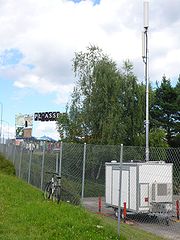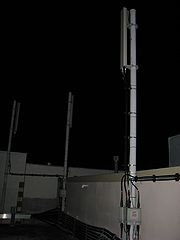
Base Transceiver Station
Encyclopedia


Cell site
A cell site is a term used to describe a site where antennas and electronic communications equipment are placed, usually on a radio mast, tower or other high place, to create a cell in a cellular network...
is a piece of equipment that facilitates wireless
Wireless
Wireless telecommunications is the transfer of information between two or more points that are not physically connected. Distances can be short, such as a few meters for television remote control, or as far as thousands or even millions of kilometers for deep-space radio communications...
communication between user equipment (UE) and a network. UEs are devices like mobile phone
Mobile phone
A mobile phone is a device which can make and receive telephone calls over a radio link whilst moving around a wide geographic area. It does so by connecting to a cellular network provided by a mobile network operator...
s (handsets), WLL
WLL
WLL can refer to:* Wireless local loop* West London Line, a railway line in London.* With Limited Liability, referring to limited liabilitiy companies * Whole Lotta Love, song by the band Led Zeppelin...
phones, computers with wireless internet connectivity, WiFi
WIFI
WIFI is a radio station broadcasting a brokered format. Licensed to Florence, New Jersey, USA, the station is currently operated by Florence Broadcasting Partners, LLC.This station was previously owned by Real Life Broadcasting...
and WiMAX
WiMAX
WiMAX is a communication technology for wirelessly delivering high-speed Internet service to large geographical areas. The 2005 WiMAX revision provided bit rates up to 40 Mbit/s with the 2011 update up to 1 Gbit/s for fixed stations...
gadgets etc. The network can be that of any of the wireless communication technologies like GSM, CDMA, WLL
WLL
WLL can refer to:* Wireless local loop* West London Line, a railway line in London.* With Limited Liability, referring to limited liabilitiy companies * Whole Lotta Love, song by the band Led Zeppelin...
, WAN
Wide area network
A wide area network is a telecommunication network that covers a broad area . Business and government entities utilize WANs to relay data among employees, clients, buyers, and suppliers from various geographical locations...
, WiFi
WIFI
WIFI is a radio station broadcasting a brokered format. Licensed to Florence, New Jersey, USA, the station is currently operated by Florence Broadcasting Partners, LLC.This station was previously owned by Real Life Broadcasting...
, WiMAX
WiMAX
WiMAX is a communication technology for wirelessly delivering high-speed Internet service to large geographical areas. The 2005 WiMAX revision provided bit rates up to 40 Mbit/s with the 2011 update up to 1 Gbit/s for fixed stations...
etc.
BTS is also referred to as the radio base station (RBS), node B (in 3G
3G
3G or 3rd generation mobile telecommunications is a generation of standards for mobile phones and mobile telecommunication services fulfilling the International Mobile Telecommunications-2000 specifications by the International Telecommunication Union...
Networks) or, simply, the base station (BS). For discussion of the LTE
3GPP Long Term Evolution
3GPP Long Term Evolution, usually referred to as LTE, is a standard for wireless communication of high-speed data for mobile phones and data terminals. It is based on the GSM/EDGE and UMTS/HSPA network technologies, increasing the capacity and speed using new modulation techniques...
standard the abbreviation eNB for evolved node B is widely used.
Though the term BTS can be applicable to any of the wireless communication standards, it is generally and commonly associated with mobile communication technologies like GSM and CDMA. In this regard, a BTS forms part of the base station subsystem
Base Station Subsystem
The base station subsystem is the section of a traditional cellular telephone network which is responsible for handling traffic and signaling between a mobile phone and the network switching subsystem...
(BSS) developments for system management. It may also have equipment for encrypting and decrypting communications, spectrum filtering tools (band pass filters) etc. antennas may also be considered as components of BTS in general sense as they facilitate the functioning of BTS. Typically a BTS will have several transceivers (TRXs) which allow it to serve several different frequencies and different sectors of the cell (in the case of sectorised base stations). A BTS is controlled by a parent base station controller via the base station control function (BCF). The BCF is implemented as a discrete unit or even incorporated in a TRX in compact base stations. The BCF provides an operations and maintenance (O&M) connection to the network management system
Network management system
A network management system is a combination of hardware and software used to monitor and administer a computer network.Individual network elements in a network are managed by an element management system.-Tasks and operational details:...
(NMS), and manages operational states of each TRX, as well as software handling and alarm
Alarm
An alarm device or system of alarm devices gives an audible or visual alarm signal about a problem or condition.Alarm devices include:* burglar alarms, designed to warn of burglaries; this is often a silent alarm: the police or guards are warned without indication to the burglar, which increases...
collection. The basic structure and functions of the BTS remains the same regardless of the wireless technologies.
General Architecture
A BTS in general has the following parts:Transceiver (TRX): Quite widely referred to as the driver receiver (DRX). DRX are either in the form of single (sTRU), double(dTRU) or a composite Double Radio Unit (DRU). It basically does transmission and reception of signals. Also does sending and reception of signals to/from higher network entities (like the base station controller in mobile telephony).
Power amplifier (PA): Amplifies the signal from DRX for transmission through antenna; may be integrated with DRX.
Combiner: Combines feeds from several DRXs so that they could be sent out through a single antenna. Allows for a reduction in the number of antenna used.
Duplexer: For separating sending and receiving signals to/from antenna. Does sending and receiving signals through the same antenna ports (cables to antenna).
Antenna: This is the structure that lays underneath the BTS; it can be installed as it is or disguised in some way (Concealed cell sites).
Alarm extension system: Collects working status alarms of various units in the BTS and extends them to operations and maintenance (O&M) monitoring stations.
Control function: Control and manages the various units of BTS including any software. On-the-spot configurations, status changes, software upgrades, etc. are done through the control function.
Baseband receiver unit (BBxx): Frequency hopping, signal DSP, etc.
Terms regarding a mobile BTS
Diversity techniques: To improve the quality of the received signal, often two receiving antennas are used, placed at an equal distance to an uneven multiple of a quarter of wavelength (for 900 MHz the wavelength it is 30 cm). This technique, known as antenna diversity or space diversity, avoids interruption caused by path fadingFading
In wireless communications, fading is deviation of the attenuation that a carrier-modulated telecommunication signal experiences over certain propagation media. The fading may vary with time, geographical position and/or radio frequency, and is often modelled as a random process. A fading channel...
. The antennas can be spaced horizontally or vertically. Horizontal spacing requires more complex installation, but brings better performance.
- Other than antenna or space diversity, there are other diversity techniquesDiversity schemeIn telecommunications, a diversity scheme refers to a method for improving the reliability of a message signal by using two or more communication channels with different characteristics. Diversity plays an important role in combatting fading and co-channel interference and avoiding error bursts...
such as frequency/time diversity, antenna pattern diversity, and polarization diversity.
Splitting refers to the flow of power within a particular area of the cell, known as sector. Every field can therefore be considered like one new cell.
Directional antennas reduce co-channel interference
Co-channel interference
Co-channel interference or CCI is crosstalk from two different radio transmitters using the same frequency. There can be several causes of co-channel radio interference; four examples are listed here....
. If not sectorised, the cell will be served by an omnidirectional antenna
Omnidirectional antenna
In radio communication, an omnidirectional antenna is an antenna which radiates radio wave power uniformly in all directions in one plane, with the radiated power decreasing with elevation angle above or below the plane, dropping to zero on the antenna's axis. This radiation pattern is often...
, which radiates in all directions. A typical structure is the trisector, also known as clover, in which there are three sectors served by separate antennas. Each sector has a separate direction of tracking, typically of 120° with respect to the adjacent ones. Other orientations may be used to suit the local conditions. Bisectored cells are also implemented. These are most often oriented with the antennas serving sectors of 180° separation to one another, but again, local variations do exist.
See also
- OpenBTSOpenBTSOpenBTS is a software-based GSM access point, allowing standard GSM-compatible mobile phones to make telephone calls without using existing telecommunication providers' networks...
- Concealed cell sites
- Cell siteCell siteA cell site is a term used to describe a site where antennas and electronic communications equipment are placed, usually on a radio mast, tower or other high place, to create a cell in a cellular network...
- Cell on wheelsCell On WheelsA cell on wheels, usually referred to as a COW, is a mobile cell site that consists of a cellular antenna tower and electronic radio transceiver equipment on a truck or trailer, designed to be part of a cellular network.-Expanded or emergency service:...
- Mobile cell sitesMobile cell sitesThe mobile cell sites are infrastructures transportable on trucks, allowing fast and easy installation in restricted spaces. Their use is strategic for the rapid expansion of cellular networks putting into service point to point radio connections, as well as supporting sudden increases of mobile...
- Radio masts and towersRadio masts and towersRadio masts and towers are, typically, tall structures designed to support antennas for telecommunications and broadcasting, including television. They are among the tallest man-made structures...

